Physical Address
304 North Cardinal St.
Dorchester Center, MA 02124
Figure-of-8 splints are primarily used for fractures about the clavicle.
Figure-of-8 splints are commercially prepared devices intended to create a reduction force on the clavicle.
No difference in outcome is seen between a figure-of-8 splint and a sling for closed management of clavicle fractures.
Minimally displaced clavicle shaft fractures
Medial physeal clavicle fractures
Closed reductions cannot be maintained and should not be attempted.
Avoid overtightening the splint; excessive tension can result in increased pain, compression of the axillary vessels, and brachial plexus neuropathy.
Reduction is not required for most clavicle fractures.
Clavicle fractures with more than 1.5 cm of overlap result in long-term disability and should be treated with open reduction and internal fixation.
Fractures that tent the skin can erode through the skin and are unlikely to heal without open reduction and internal fixation.
A figure-of-8 splint
Patient positioning:
Standing
Landmarks:
Clavicle
Acromioclavicular joint
Steps:
Have the patient stand.
Fit the patient with a figure-of-8 splint.
The figure-of-8 splint should be placed so that the center of the “8” rests on the upper back.
Have the patient stand ( Fig. 13.1 ).
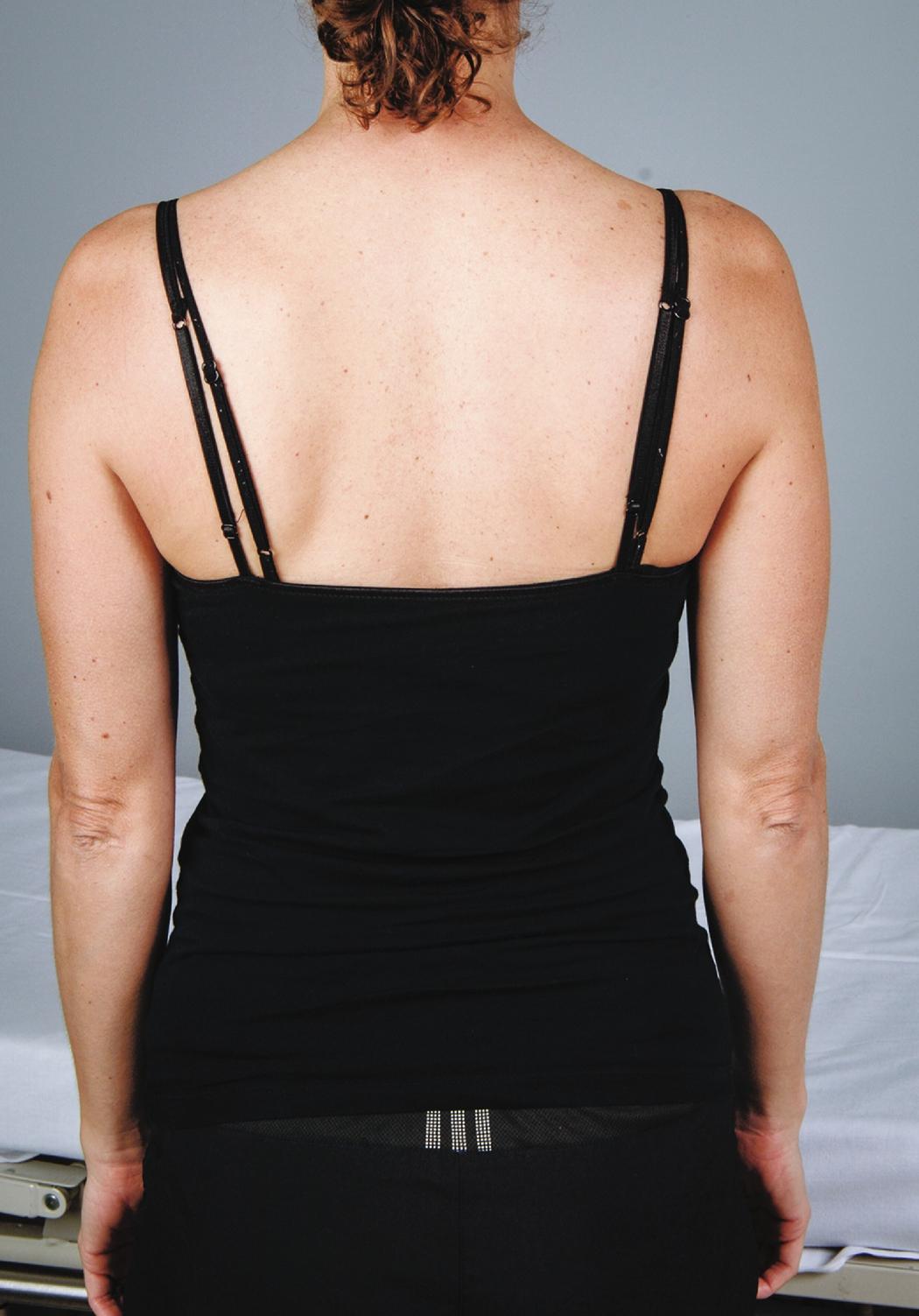
Apply the figure-of-8 splint so that the center of the “8” comes to rest between the shoulder blades on the upper back ( Fig. 13.2 ).
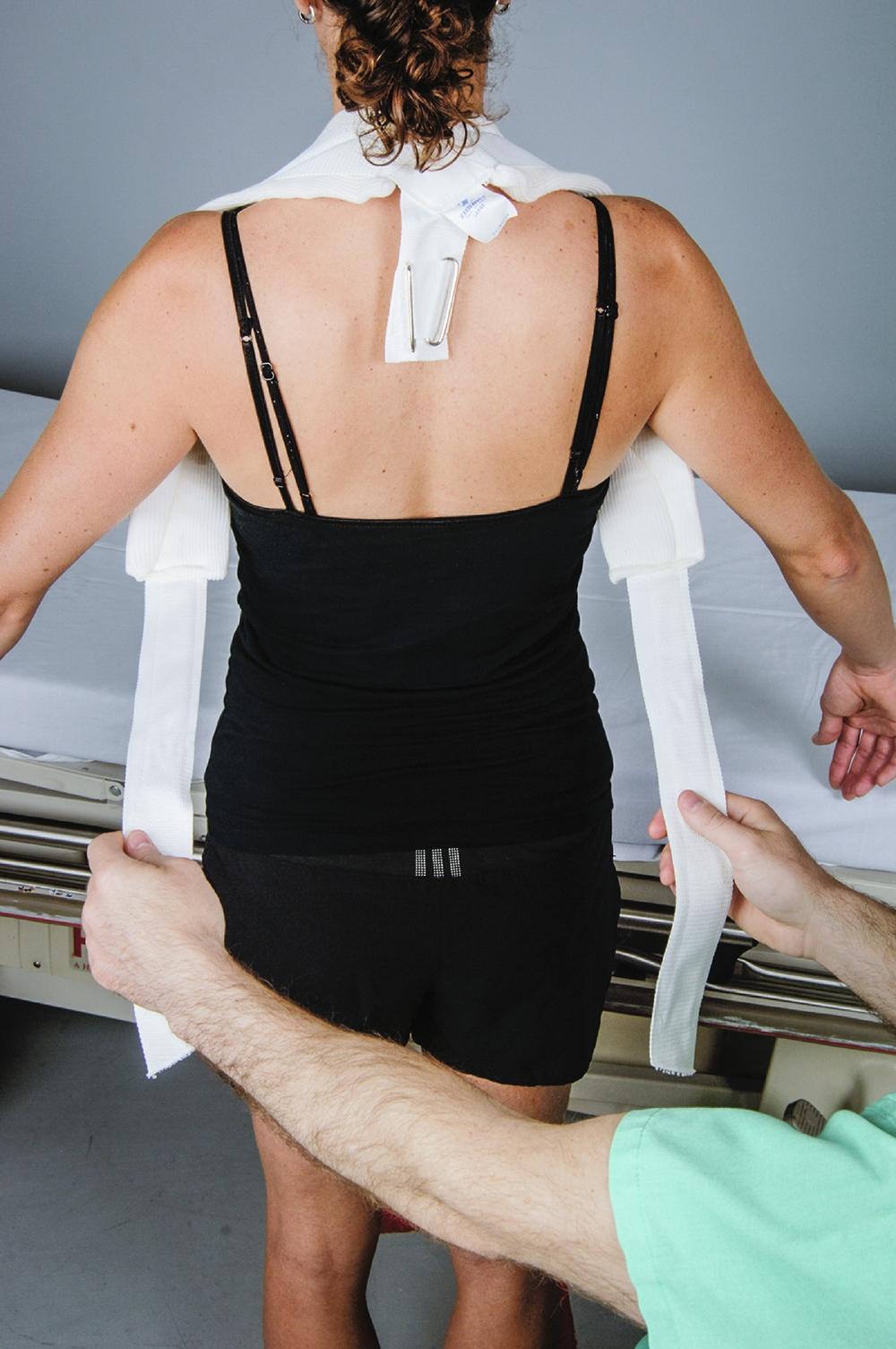
Adjust the figure-of-8 dressing so that it is as tight as possible while still being comfortable to wear ( Figs. 13.3 and 13.4 ).
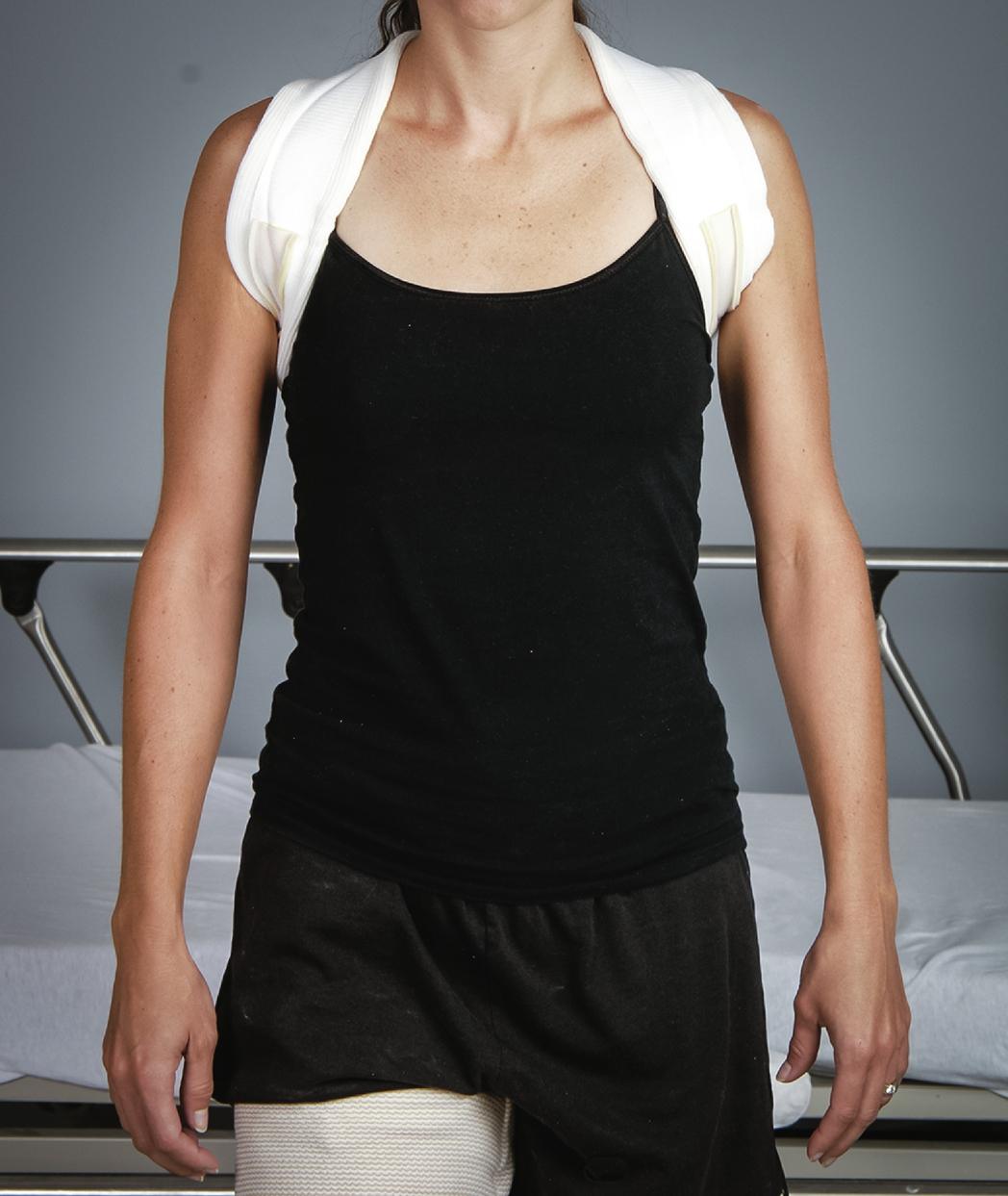
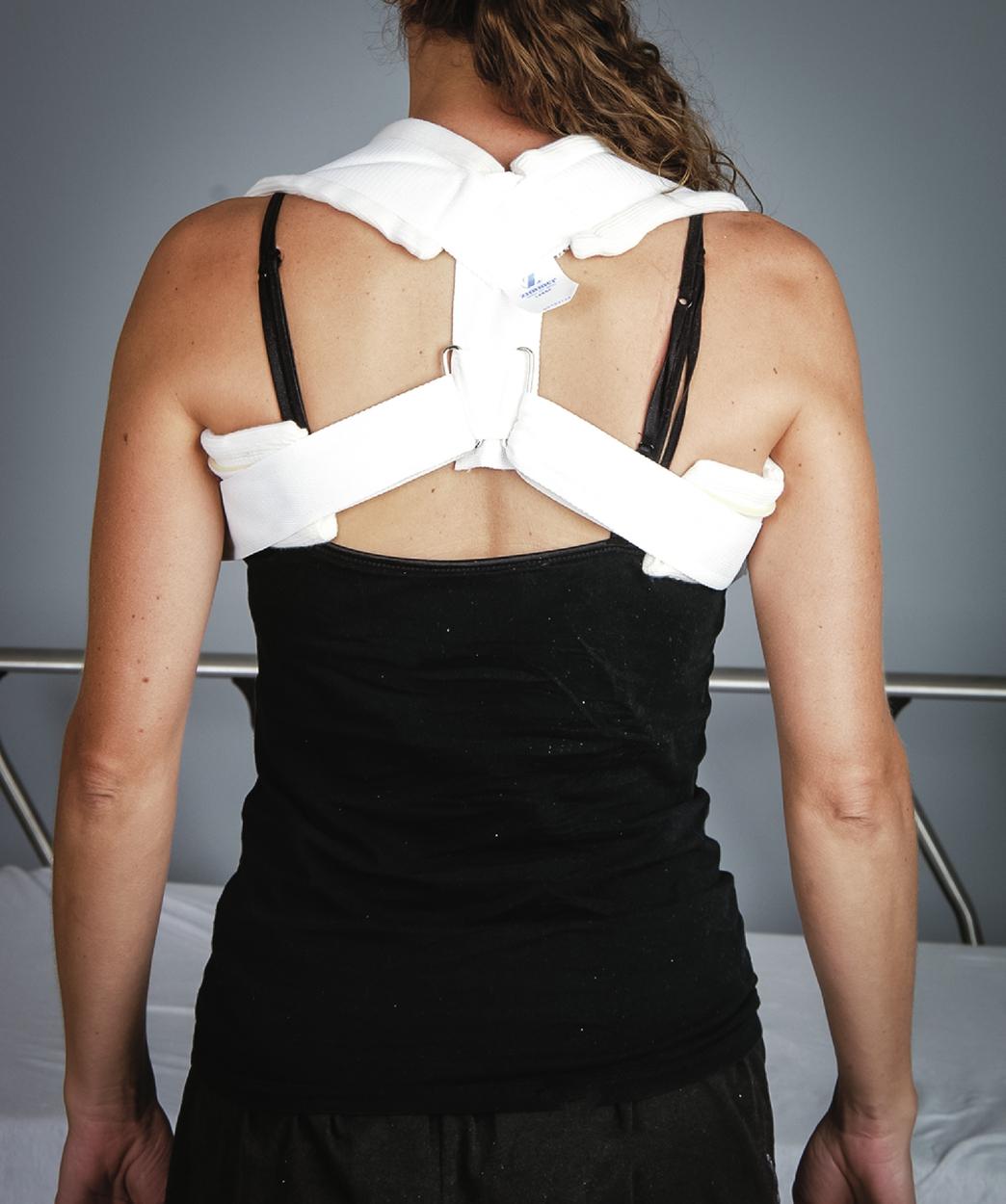
“Though simple in form and principle, this sling is rich in security, ease, and comfort.”— W.C. Wermuth, MD, 1908
An arm sling is used for a variety of conditions.
A swath wrapped around the body is added for shoulder immobilization.
Sling:
Clavicle fractures
Minimally displaced proximal humerus fractures
Acromioclavicular separations
Support for splints and casts of the upper extremity
Sling and swath: moderately displaced proximal humerus fractures where the humerus does not move as a single unit
Ensure a proper fit to prevent pressure complications at the back of the neck. It is recommended that a well-padded sling be used or that the neck be padded with cast padding and/or an ABD pad.
Elderly patients and patients with compromised skin (such as persons taking steroids on a long-term basis) should be closely monitored for skin breakdown.
The adult elbow does not tolerate immobilization well. If possible, given the nature of the injury, the patient should be instructed to perform daily elbow, wrist, and hand range-of-motion exercises.
If a reduction maneuver has been performed, then obtain postreduction radiographs while the patient is wearing the sling or the sling and swath to ensure maintenance of the reduction.
An arm sling or a sling and swath
Cast padding or an ABD pad
Talcum powder (optional)
An arm sling and 6-in. elastic bandage can be used if a commercial sling and swath are not available.
Patient positioning:
Standing
Landmarks:
Clavicle
Acromioclavicular joint
Acromion
Steps:
Sling:
Have the patient stand.
Fit the patient with a sling.
The sling should provide support for the weight of the arm.
Sling and swath:
Have the patient stand.
Place an ABD pad with talcum powder (optional) in the axilla.
Fit the patient with a sling.
Apply the swath.
Sling:
Have the patient stand.
Pad the neck strap of the sling to prevent pressure complications at the back of the neck ( Figs. 13.5 and 13.6 ).


Apply the sling and adjust the straps.
Adjust the sling so that it is tight enough to support the weight of the arm ( Fig. 13.7 ).
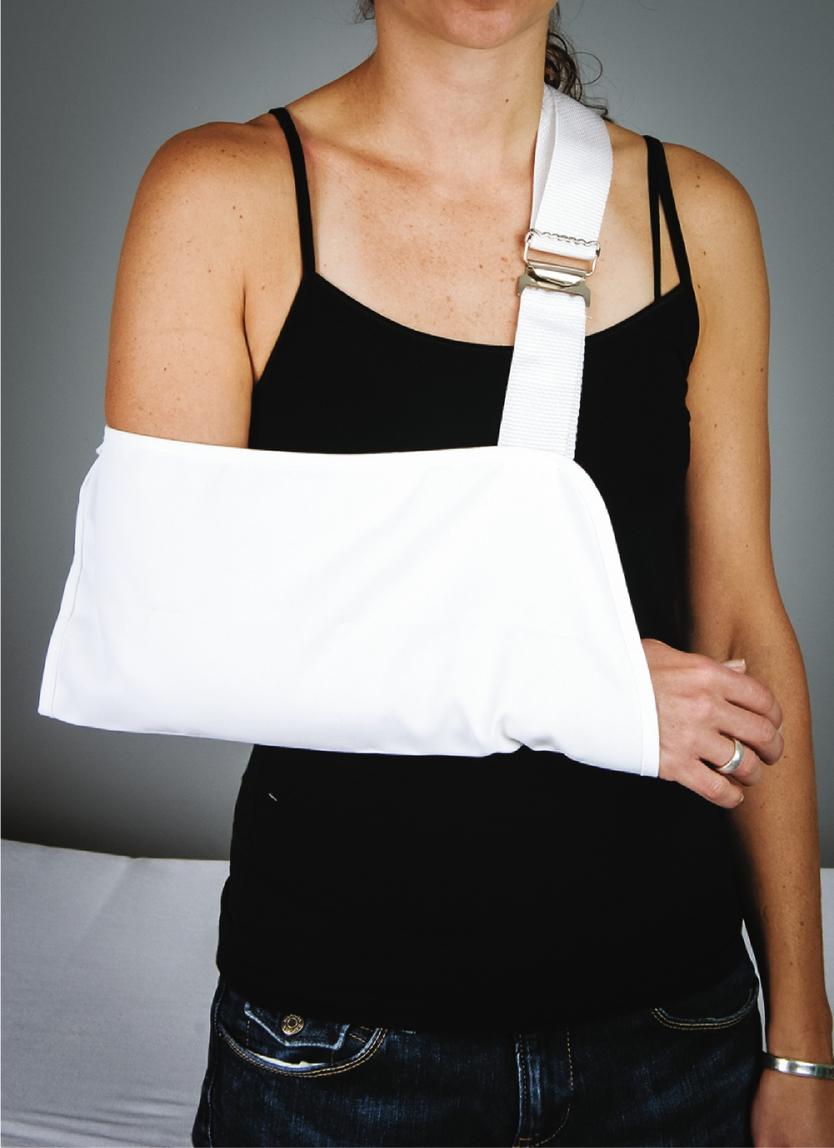
Sling and swath:
Have the patient stand.
Pad the neck strap of the sling to prevent pressure complications at the back of the neck.
Place talcum powder on the ABD pad and fold the pad in half, with the talcum side facing out ( Fig. 13.8 ).

Place the folded ABD pad in the axilla to absorb perspiration.
Apply the sling and adjust the straps so that it is loose while providing some support for the weight of the arm.
Buckle and adjust the circumferential body strap ( Fig. 13.9 ).
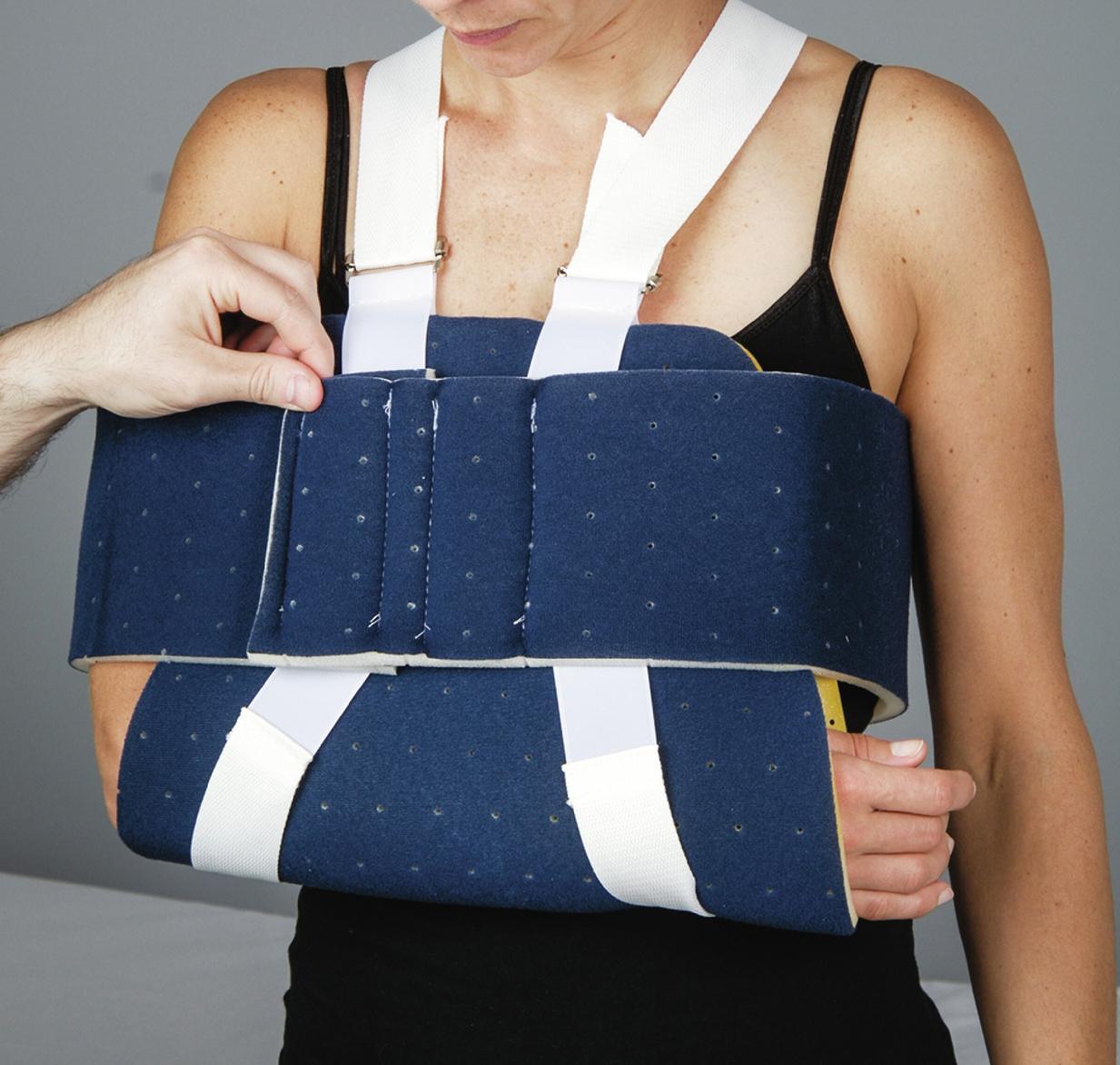
If using only a sling, then swath the arm to the body using cast padding ( Fig. 13.10 ), followed by application of a large elastic bandage ( Fig. 13.11 ).


The correct application of either of the methods described in the following will ensure that the coaptation splint remains secure and does not fall out of place.
See Chapter 9 for a discussion on reduction of humeral shaft fractures.
Humeral shaft fractures
Do not allow one end of the coaptation splint to end at the fracture site; otherwise, the splint terminus will become a fulcrum and cause more displacement.
An ABD pad can be placed in the axilla after the splint is applied (see Fig. 13.8 ).
Use of an ABD pad prevents direct compression of the brachial plexus.
An ABD pad absorbs moisture.
When using the hanging stockinette modification technique, pay close attention to which side of the splint is padded. Ensure that the well-padded side is facing toward the patient.
Coaptation splints have a reputation for being poorly made and for sliding down the arm.
The key to properly applying a coaptation splint is to ensure that the splint always comes above the arm onto the shoulder ( Fig. 13.12 ).
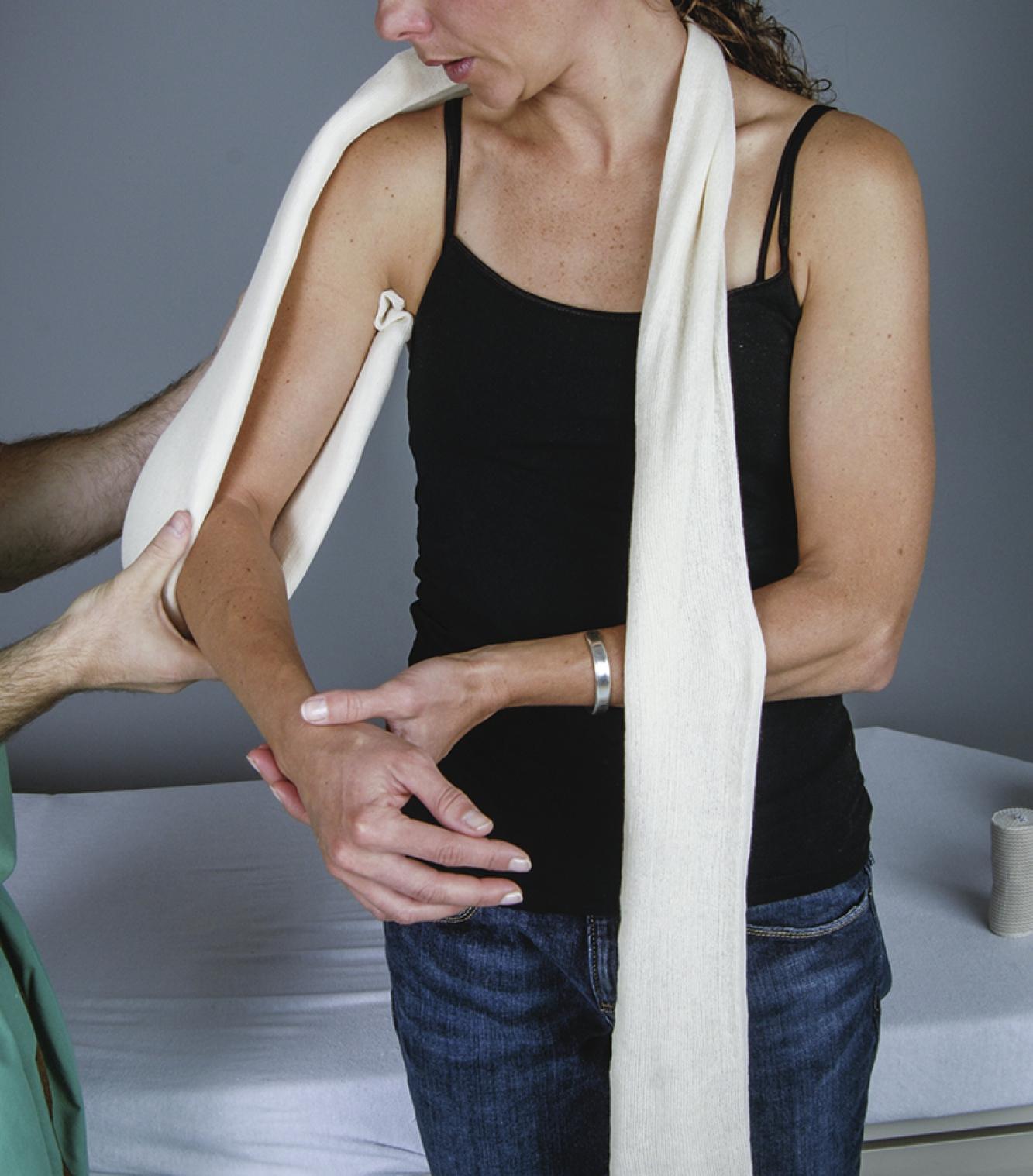
Use a technique that allows the coaptation splint to be secured around the body to prevent distal displacement. An extra-long elastic or self-adherent bandage is a useful adjunct for a coaptation splint.
When applying the splint, have the patient turn his or her head to the contralateral side, which prevents the neck from pushing down the splint during application.
We prefer using a self-adhesive bandage to overwrap the plaster because it acts predictably during application, stays in place well, and looks better than other options.
Stockinette: 4 in. wide, 6 ft long
Cast padding: 4 in. wide
Plaster: 4 in. wide
Elastic or self-adherent bandage: 4 in. wide
A silk tape: 2 in. wide (optional)
A bucket of tepid water
Patient positioning:
If possible, have the patient stand or sit up with his or her back off the stretcher.
The elbow should be placed at 90 degrees.
If the patient is unable to sit up, then move the head of the bed as upright as possible.
Where to start:
As high into the axilla as possible
If the fracture is in the proximal third of the humeral diaphysis (right at the level of the axilla on the radiograph), then start the splint lower.
Where to finish:
At the base of the neck
Where to mold:
Lateral aspect, distal to the fracture site
Steps:
Measure the length of the splint using plaster.
Roll out the cast padding.
Roll out the plaster.
Cut a 6-ft length of the 4-in. stockinette.
Position the patient.
Prepare the plaster in the usual manner.
Place a splint inside the stockinette.
Apply the splint.
Definitively secure the splint with an elastic bandage.
Complete the stockinette.
Measure the length of the splint.
Use the contralateral side.
Hold one hand in the axilla and wrap the plaster around the elbow until the base of the neck is reached.
Mark the length on the plaster by making a small tear on one side.
Roll out the plaster ( Fig. 13.13 ).
The plaster slab should be 10–12 sheets thick.
Use the measured length.

Roll out the cast padding ( Fig. 13.14 ).
Use the usual technique that will allow the cast padding to be folded over (see Chapter 12 ).
Add at least 6 in. of length so that the splint may be folded over.

Cut a 6-ft length of the 4-in. stockinette.
Position the patient ( Fig. 13.15 ).
Have the patient sit upright if possible.
Place the patient’s elbow at 90 degrees.
Ensure that the patient’s head is facing toward the contralateral side.
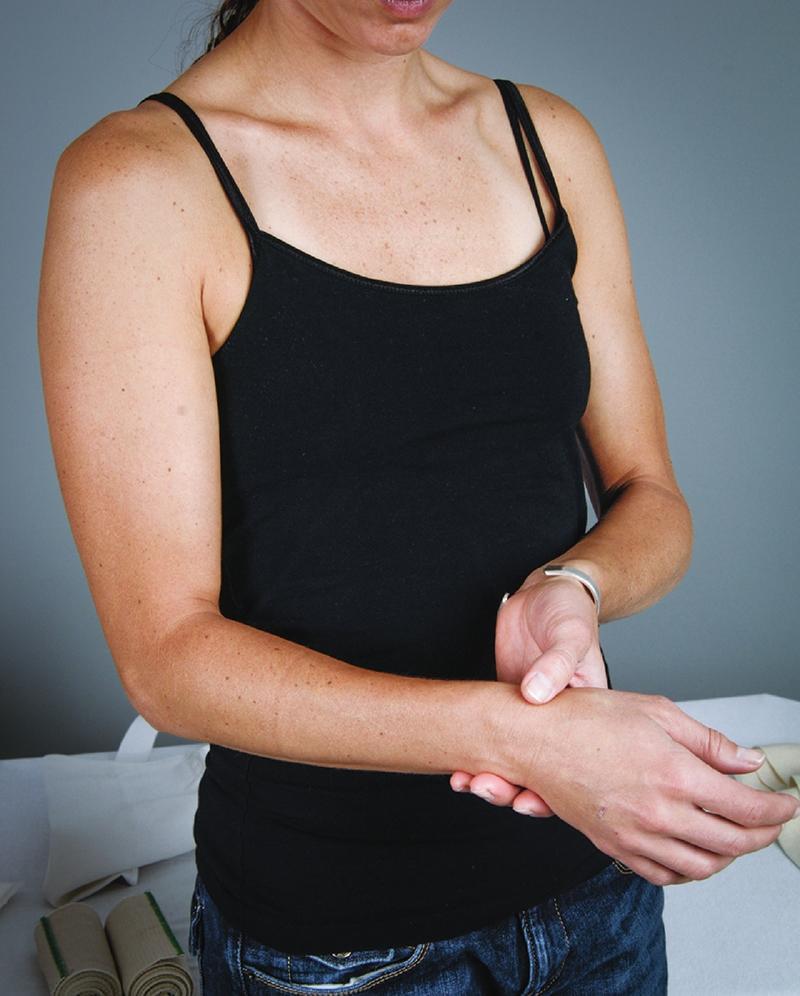
Prepare the plaster in the usual manner ( Figs. 13.16 and 13.17 ). Use the usual technique of wetting and laminating, followed by placement in cast padding (see Chapter 12 ).


Place the splint inside the stockinette ( Fig. 13.18 ).
Initially placing the entire length of the stockinette on the surgeon’s forearm is helpful.
Hold one end of the splint with the arm containing the stockinette.
Pull the stockinette to the end of the splint.
Do not forget which side of the splint is padded!
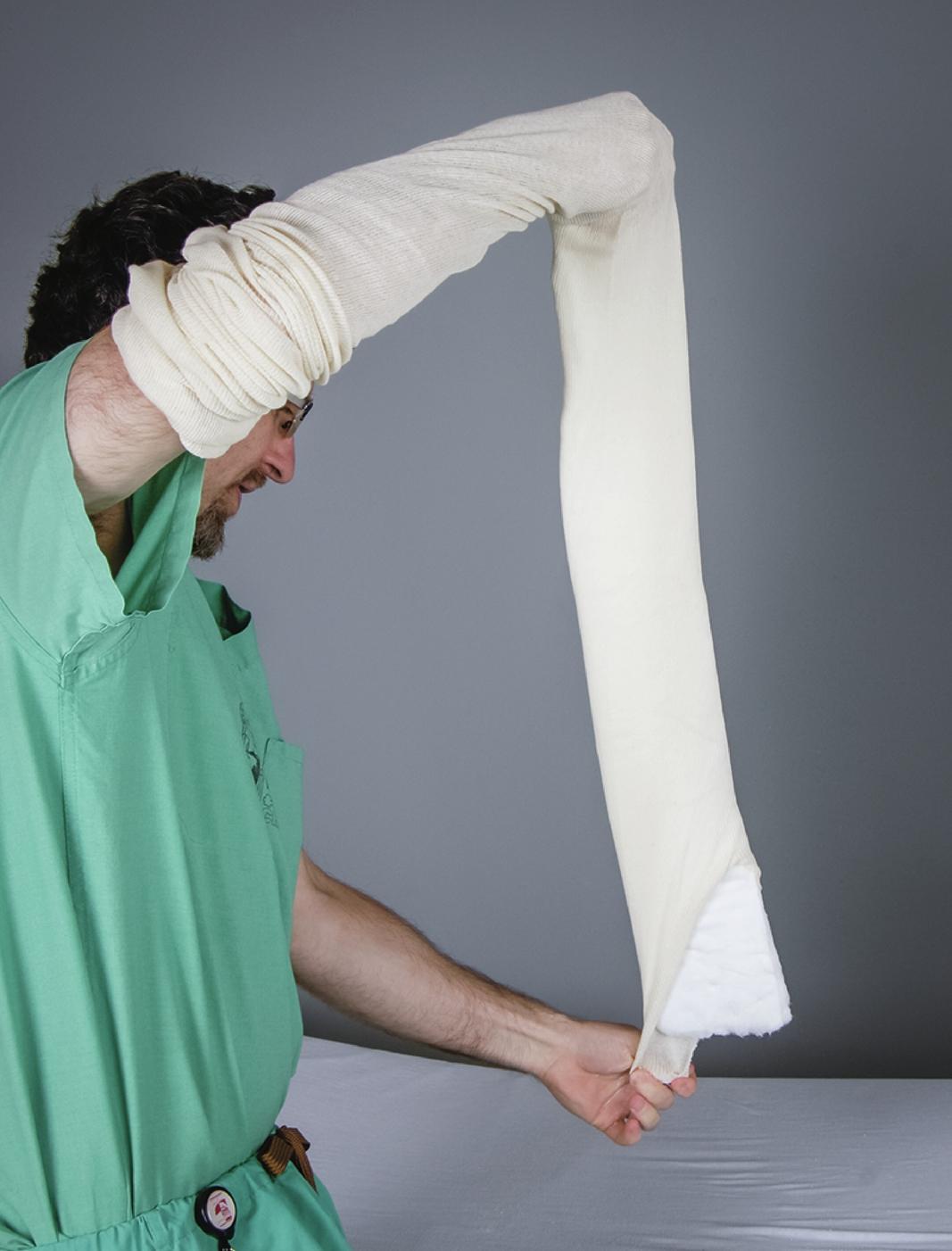
Apply the splint (see Fig. 13.12 ).
Start in the axilla or at an appropriate starting point given the fracture site. Provisionally secure it with cast padding at the middle arm.
Loop the splint around the elbow. Again, provisionally secure it with cast padding at the middle arm.
Momentarily fold the remaining part of the splint down.
Pass the loose end of the stockinette around the neck.
Definitively secure the splint with an elastic or self-adherent bandage ( Fig. 13.19 ).
Wrap the elastic or self-adherent bandage around the arm and splint.
Having an assistant support the arm and/or the splint can be helpful.

Apply the mold. Most fractures require a two-point mold, with one hand anterolateral at the fracture site and the other posteromedial at the elbow ( Fig. 13.20 ).

Complete the stockinette ( Figs. 13.21 and 13.22 ):
Tie a slip knot at the loose end of the stockinette (an overhand knot with a draw loop).
Place the wrist of the affected side inside the slip knot to create a collar-and-cuff-type construct.


Place a cast padding wedge under the arm to counteract varus displacement of the fracture (optional) ( Figs. 13.23 and 13.24 ).

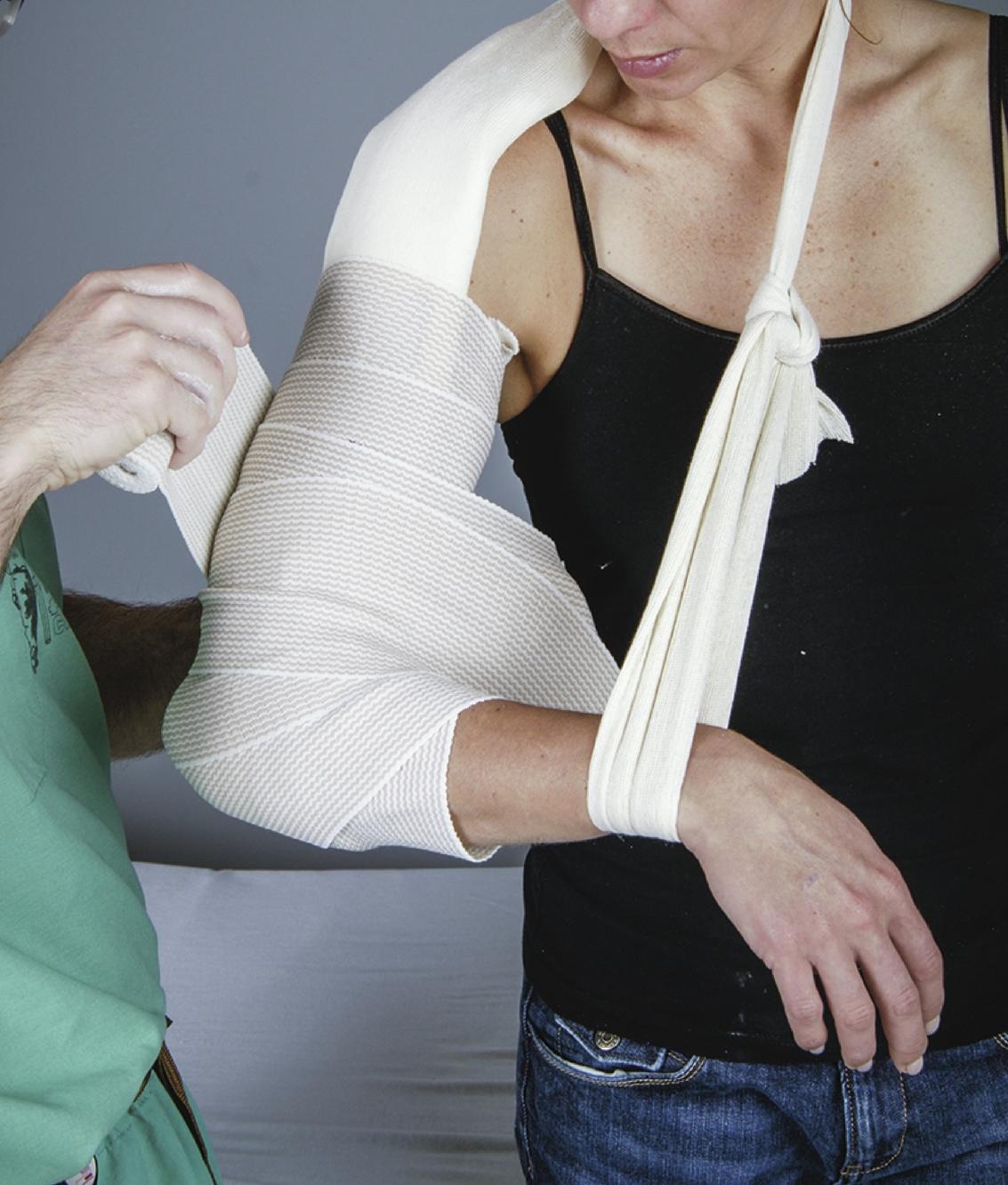
A posterior slab may be added to control elbow motion for more distal fractures ( Figs. 13.25 and 13.26 ).


A posterior elbow splint is inherently weak. Struts must be added to prevent elbow extension in the splint.
Two techniques are described for stabilization of the posterior elbow splint:
External struts with tape
Internal struts with plaster
Fractures about the elbow
Postoperative/postinjury elbow immobilization
Elbow dislocations
The wrist is usually immobilized to control for pronation and supination about the elbow. Elbow dislocations should be splinted in at least 90 degrees of flexion with the wrist in pronation.
Ensure that the splint remains proximal to the palmar flexion crease to preserve complete finger range of motion.
At the antecubital fossa, do not allow the edges of cast padding to immediately lay within the fossa borders.
Allowing the edges of cast padding to immediately lay within the fossa borders will create wrinkling and can lead to skin breakdown in this highly fragile area.
Span the fossa by having the midpoint of the cast padding roll directly over the elbow flexion crease.
By having the midpoint of the cast padding roll directly over the elbow flexion crease, the cast padding will be slightly tented above the fossa and will not be in direct contact, thus reducing the risk of skin breakdown.
Because the olecranon and ulnar styloid are at risk in this splint, care should be taken to apply additional padding over these areas.
A posterior elbow slab is extremely weak and does not provide significant immobilization.
Some form of strut must be made to prevent flexion/extension.
The struts can be either internal or external to the splint:
Internal struts are made of plaster and directly applied to the posterior slab, providing resistance to both flexion and extension.
External struts are made of tape and applied to the splint after it is definitively secured, providing resistance to extension but not to flexion.
Have the patient or an assistant hold the hand of the affected side by the fingertips to help with positioning and reduce pain.
Cast padding: 3 in. wide
Plaster: 4 in. wide and 2 in. wide
Elastic or self-adherent bandage: 4 in. wide
A bucket of tepid water
Tape (optional): 2 in.
Patient positioning:
The patient should sit upright with his or her shoulder off the side of the bed.
The elbow should be in the desired position of flexion and pronation/supination.
Where to start:
Proximal to the palmar flexion crease
Where to finish:
Immediately distal to the axillary fold of the arm
Where to mold:
Slight supracondylar mold above the elbow
Measure the length of the splint using plaster.
Use the contralateral side.
Start proximal to the palmar flexion crease.
End immediately below the axillary fold.
Roll out the plaster.
The posterior slab should be 10–12 layers thick and 4 in. wide.
Side struts can be 8–10 layers thick and 2 in. wide.
Position the patient:
Standing or sitting upright
Arm freely off to the side
Elbow bent to the desired degree of flexion
Wrap the extremity in cast padding.
Start at either end ( Fig. 13.27 ).

Circumferentially wrap with cast padding, using a standard 50% overlap technique (see Chapter 12 ). Two layers of wrapping are sufficient.
Carefully tear the cast padding so that it conforms around the thumb interspace. Do not go past the palmar flexion crease.
Span the fossa with cast padding at the antebrachial fossa (see aforementioned precautions).
Tear several small strips of cast padding and apply them over the bony prominences of the olecranon and ulnar styloid to provide additional padding ( Fig. 13.28 ).

Create three cast padding cuffs (see Chapter 12 ):
Palmar flexion crease/metacarpal heads ( Fig. 13.29 ): This cuff should form a “V” at the ulnar aspect of the hand to allow for the cascade of the digits.

Thumb: This cuff should form a “V” at the base of the thumb ( Fig. 13.30 ).
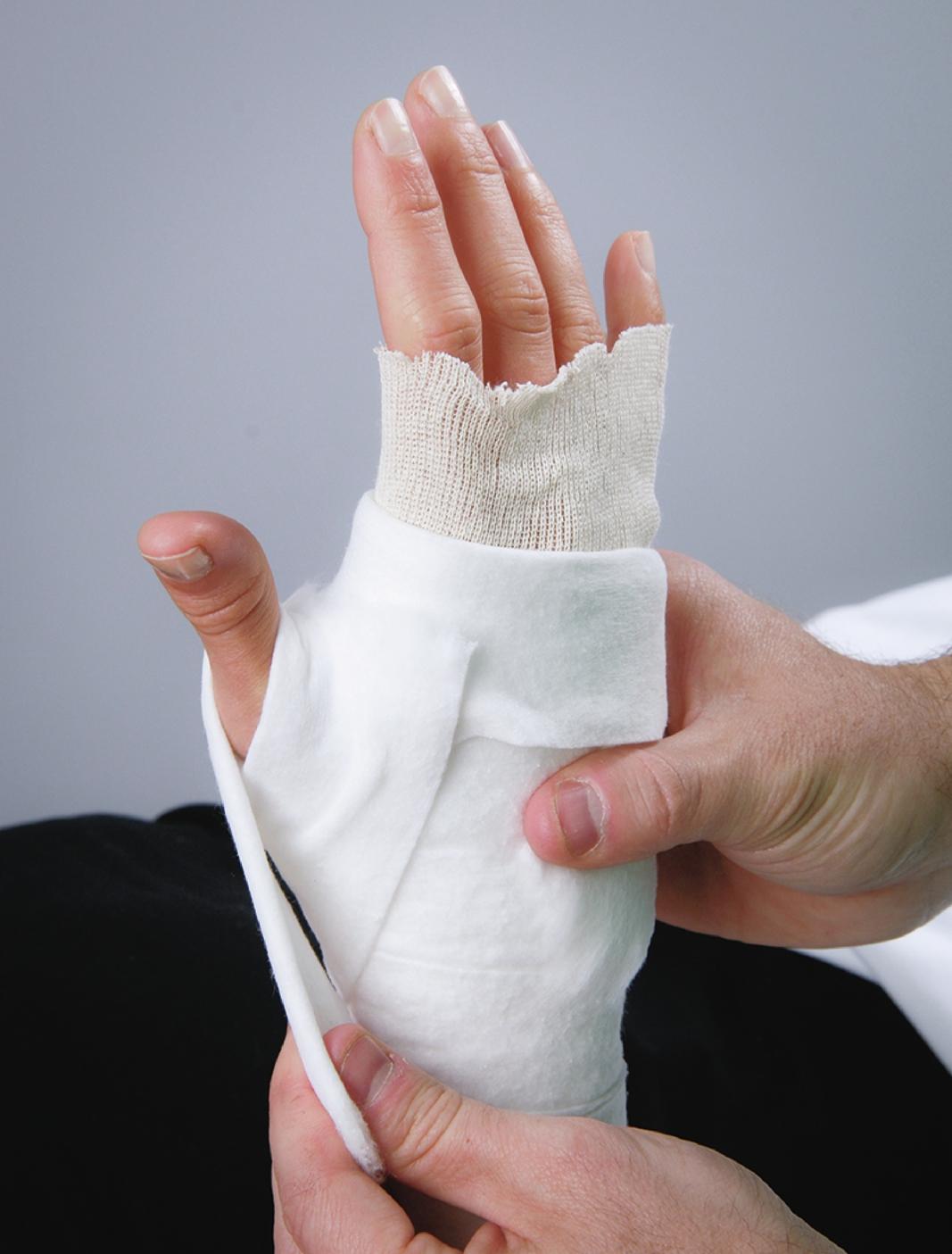
Proximal forearm ( Fig. 13.31 ): This cuff can be circular.

Prepare the plaster. Use the usual technique of wetting and laminating (see Chapter 12 ).
Apply the plaster.
Apply the posterior slab first ( Fig. 13.32 ).
Position the posterior slab over the ulnar border of the forearm, around the olecranon and the posterior aspect of the arm.
Provisionally secure with cast padding at the wrist, forearm, and arm if necessary.

Apply side struts (if not using external struts).
Start laterally at the mid arm and angle obliquely toward the forearm ( Fig. 13.33 ). Laminate the side strut to the posterior slab.
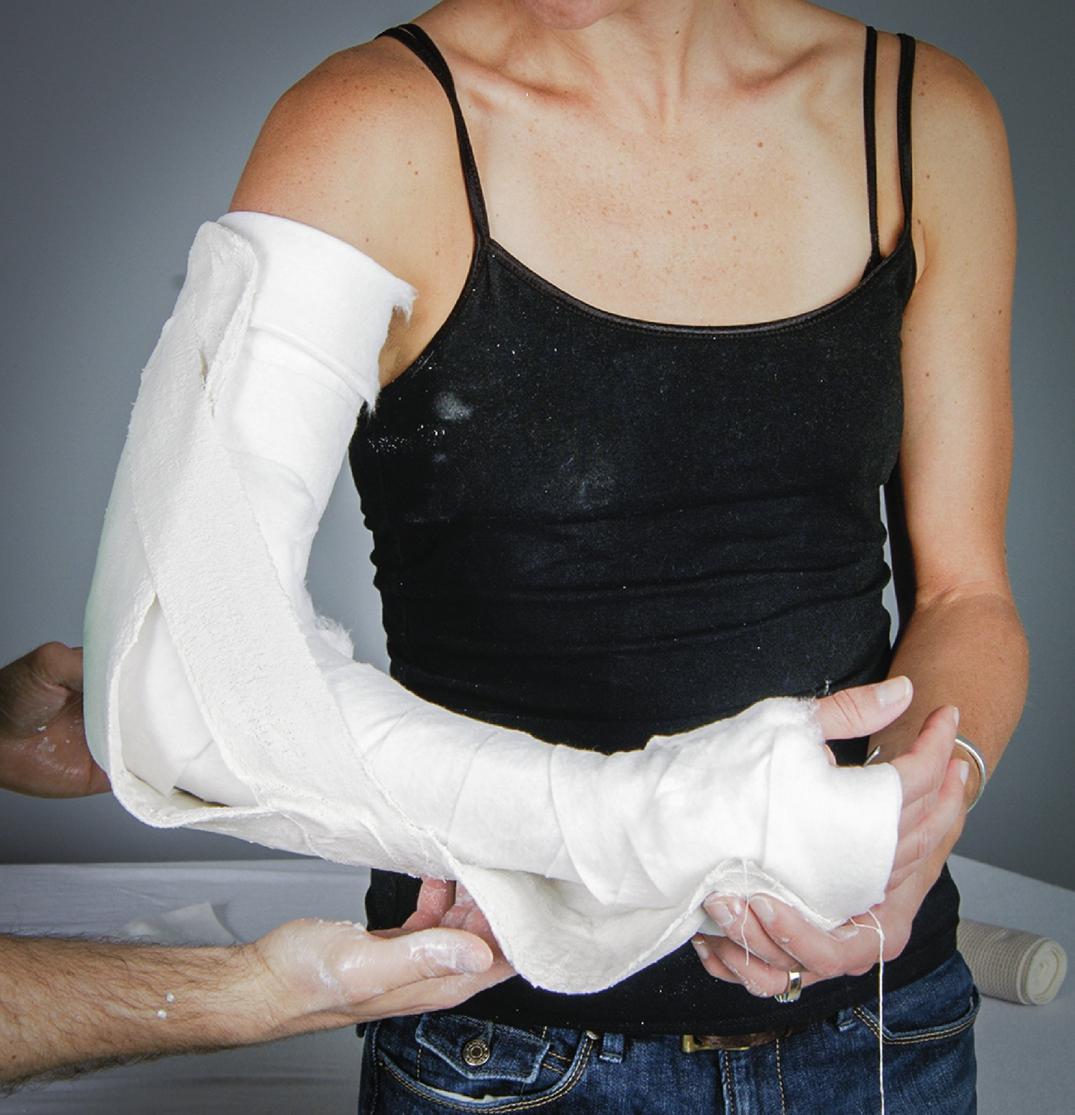
Apply the medial side strut in the same position if additional stability is needed. Laminate the side strut to the posterior slab.
Cover the plaster. Wrap cast padding on top of the plaster to prevent adhesion of the plaster to the elastic or self-adherent bandage ( Fig. 13.34 ).
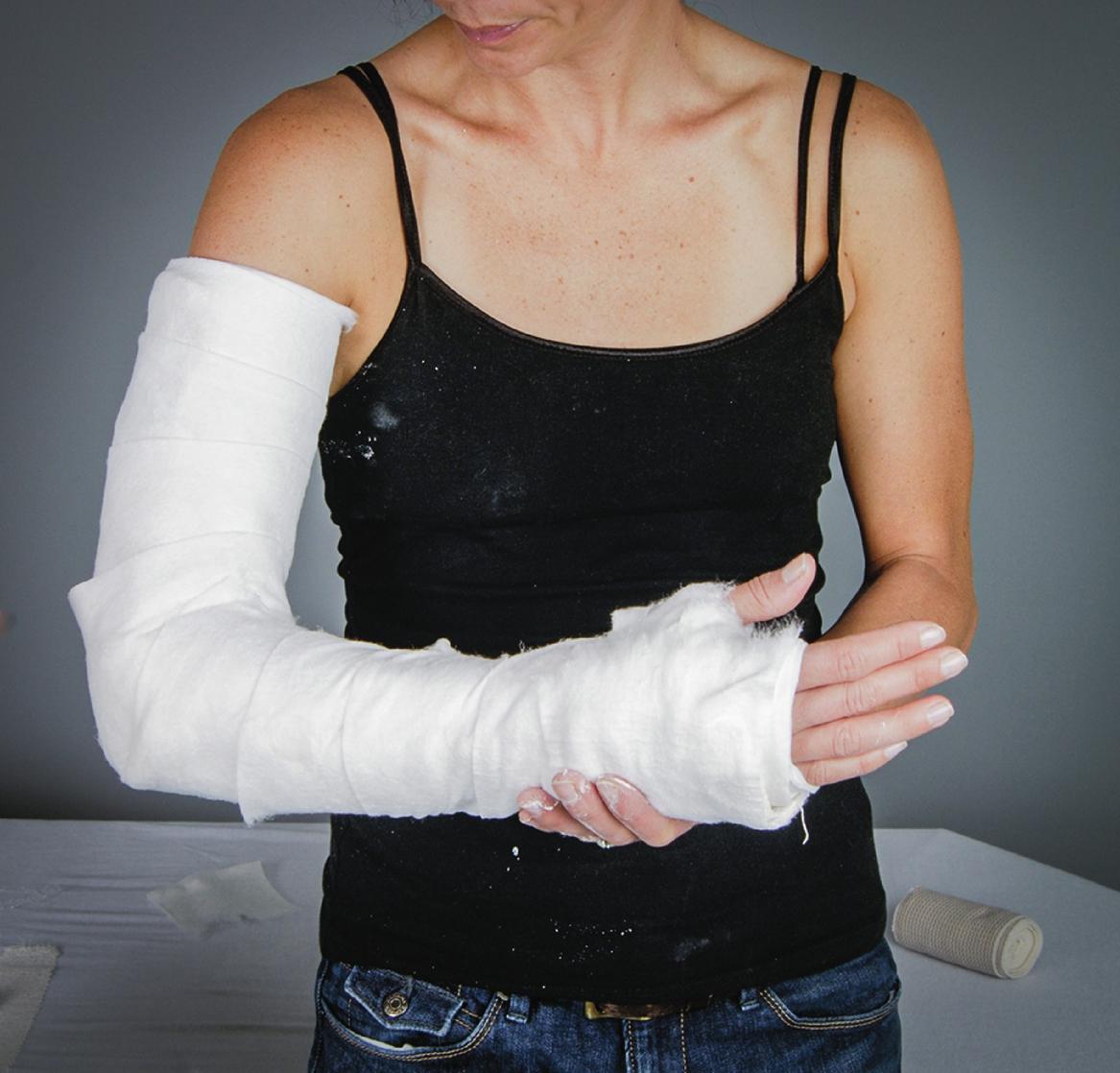
Definitively secure the splint with an elastic or self-adherent bandage ( Fig. 13.35 ).

Apply molding if necessary.
Create an external strut (if no internal struts are used) after the plaster has set ( Fig. 13.36 ). Use the figure-of-8 technique with tape.
Take a 2-in. silk tape and begin at the midpoint of the posterior aspect of the arm ( Fig. 13.37 ).
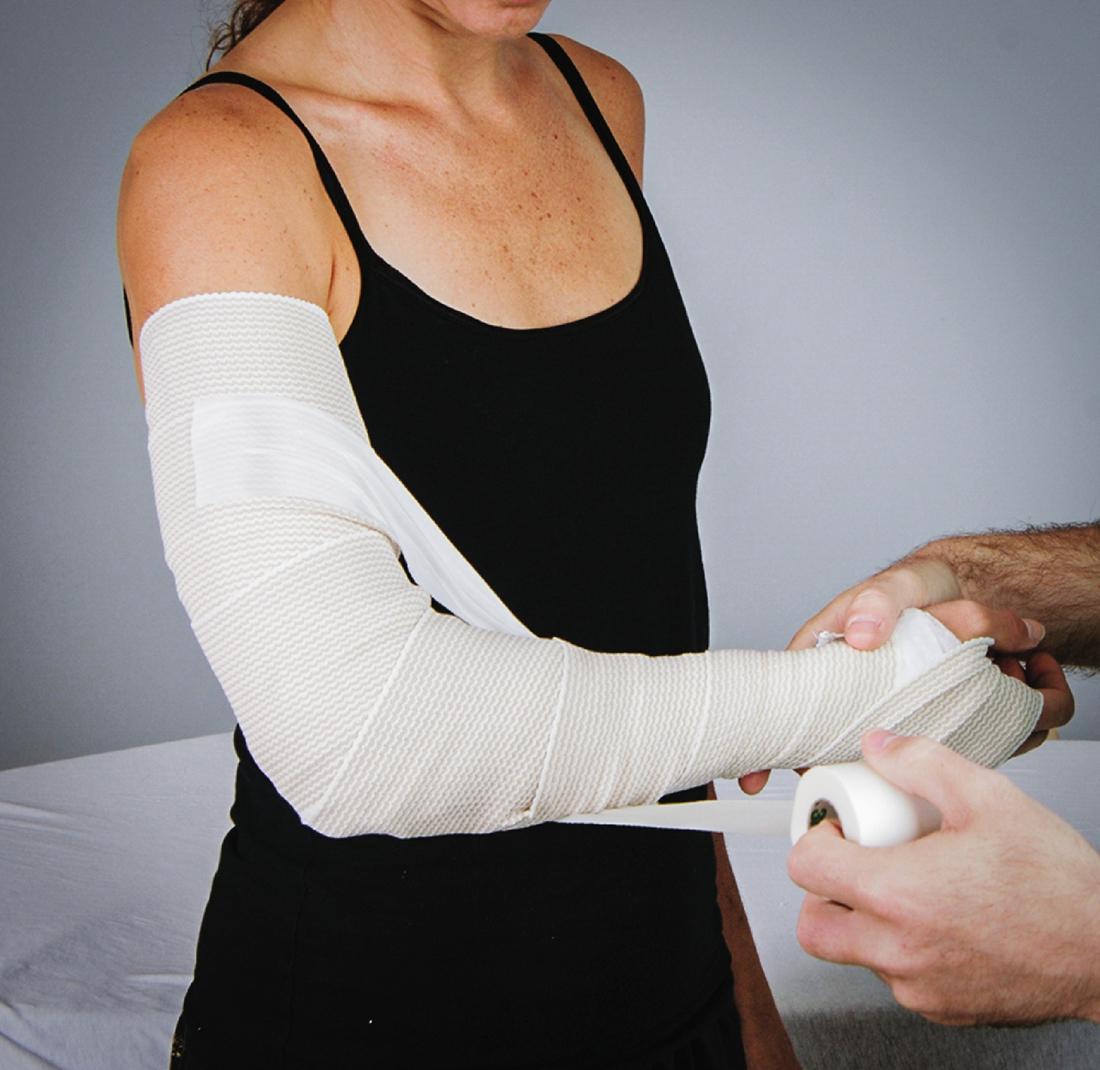
Wrap around to the midpoint of the anterior aspect of the arm.
Span the fossa obliquely.
Attach tape to the opposite aspect of the forearm.
Wrap around the dorsal forearm ( Fig. 13.38 ).
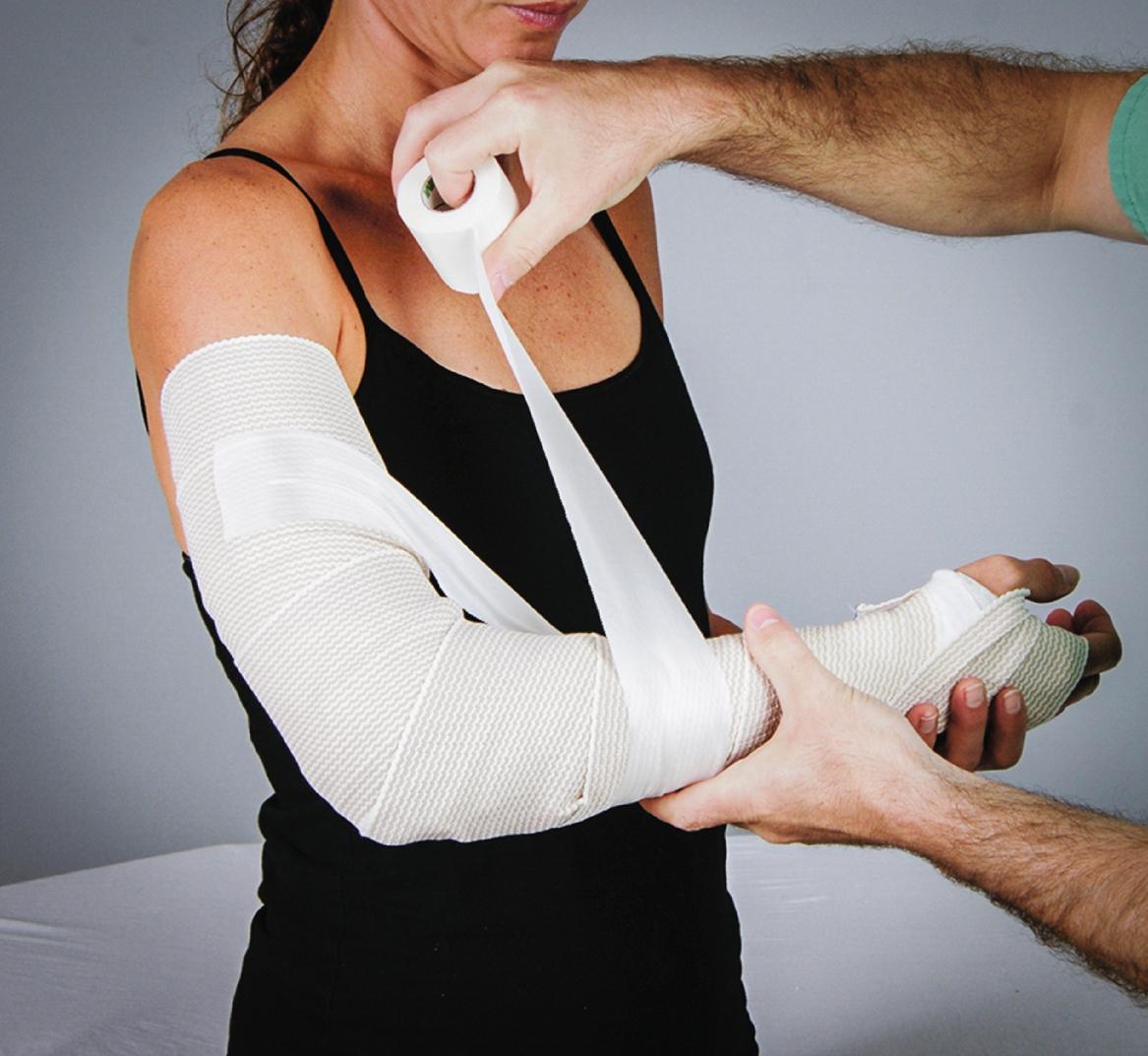
Span the fossa obliquely.
Attach tape to the lateral aspect of the arm ( Fig. 13.39 ).

At the intersection of the figure of 8, wrap with tape ( Fig. 13.40 ).
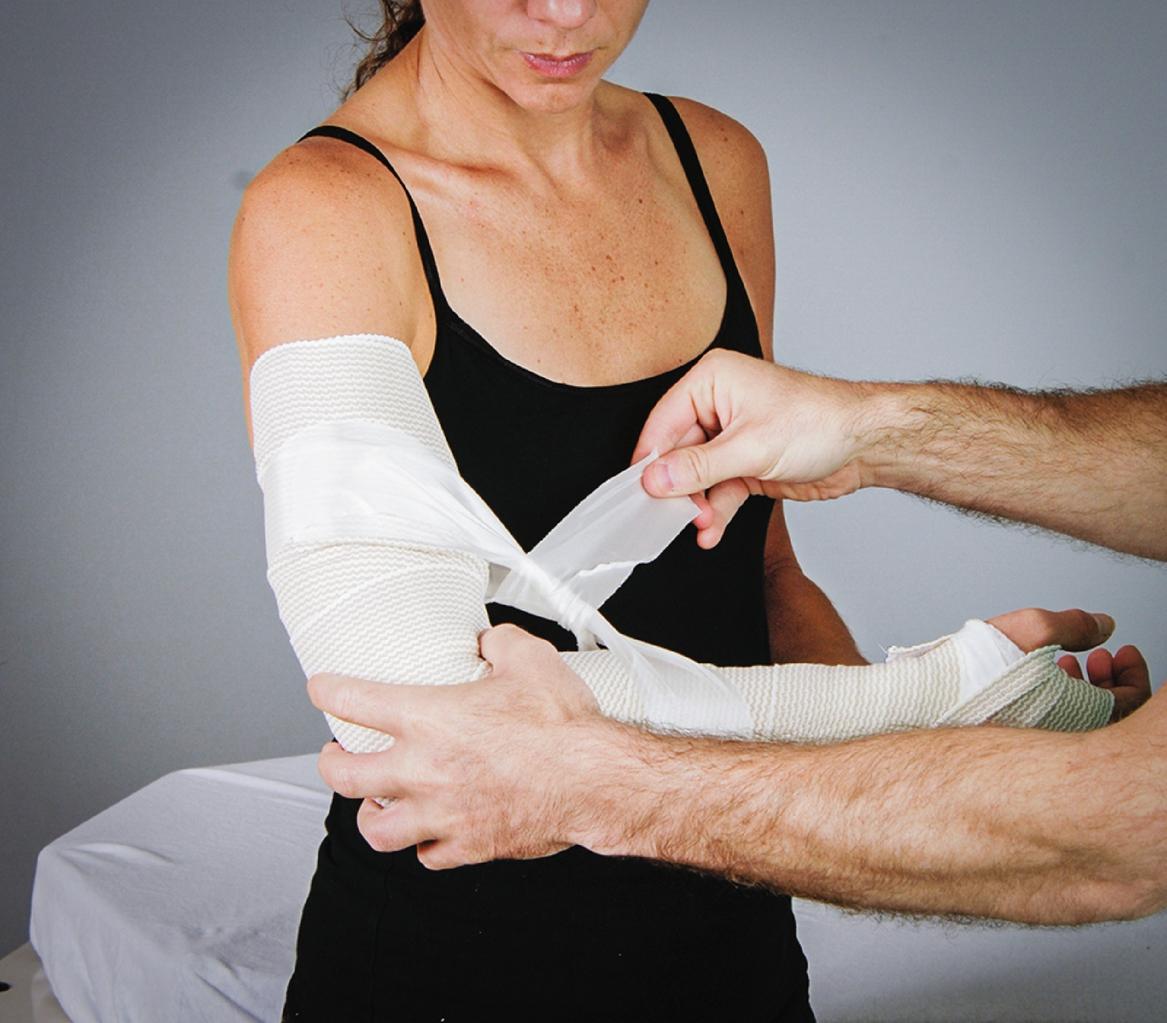

Pediatric supracondylar humerus fractures
Pediatric forearm fractures
Pediatric unstable distal radius fractures
Adult distal radius fractures
Adult forearm fractures
Become a Clinical Tree membership for Full access and enjoy Unlimited articles
If you are a member. Log in here